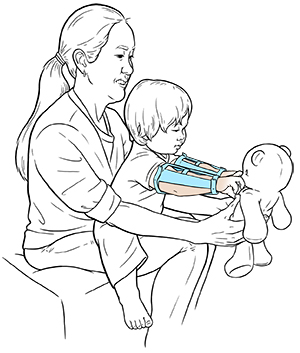Your baby or toddler recently had surgery to help fix their cleft lip, cleft palate, or both. As your child recovers, take these steps to help make sure that they heal correctly.
Giving medicine
-
Give your child any prescribed pain medicine as directed. It’s best not to wait until pain gets bad to give the medicine. You may not know when your child is feeling pain, so watch for signs. Your child may be in pain if they:
-
Are grouchy or fussy.
-
Won't eat or drink.
-
Cry a lot.
-
-
Your child’s health care provider will tell you when to give your child medicine. If the pain medicine doesn’t seem to be working, let the provider know right away.
-
Your child's provider will prescribe antibiotics to prevent infection. Give your child the antibiotics exactly as instructed.
Protecting the wound
To protect your child’s skin and help incision sites heal correctly:
-
Keep the incision sites as dry as possible. Regular, gentle patting of the mouth with a clean cloth can help.
-
Don’t put any cream or lotion on the incisions unless directed to do so.
-
Keep your child’s hands away from the incisions. To do so, you may need to use gentle restraints (see below) on your child's arms for
7 to 10 days after surgery. Nursing staff will show you how to do this safely.
Feeding your child
Your child’s health care provider will decide the best way for your child to eat after the surgery. Detailed instructions will be given to you so that you can feed your child at home. Follow these instructions closely. Ask to feed your child in the hospital before discharge. This will help you to be comfortable with any adjustments that need to be made. You may be told to:
-
Feed your child by mouth, but only soft or liquid foods. Do this for at least
10 days or as directed by your child's provider. Don't use straws or crunchy foods. -
Give special feedings with a rubber-tipped syringe if needed. This keeps the child from swallowing. That causes the palate muscles to pull apart and open the stitches.
Issues and concerns after surgery
-
Gentle restraint. After surgery, your child’s arms may need to be gently restrained. This is to keep them from touching the wound. These soft arm restraints may look odd at first. But they are needed to protect your baby’s mouth. Ask to practice putting on the restraints in the hospital. This will help you feel comfortable doing it.
-
Eating and drinking. Feeding can be hard after surgery. Your child’s mouth will be sore and swollen. It will also take time for your child to get used to the new shape of their mouth. If your child has a cleft palate, they will need to relearn how to swallow. The speech pathologist will work with you and your child during this time. This is to be sure your child can eat and drink.
-
Ear infections. A child with a cleft palate is more likely to get ear infections, even after repair surgery. To prevent this, tiny ear tubes to help drain fluid from the ear may be put into the child’s eardrums. These tubes are often put in during repair of a cleft palate. As your child grows, the tubes will likely need to be replaced.
Long-term concerns
-
More surgery. Your child may need a number of surgeries to repair the lip, nose, gum, or palate. Your child’s health care team will work with you to schedule any other needed surgeries.
-
Emotional support. The health care team will talk to you and your child about any ongoing needs, issues, or concerns related to your child’s cleft. Ask any questions you may have.
-
Family support. It can be very hard to deal with this condition. It can cause emotional and financial strain on the whole family. If your family needs help, talk with the hospital's social worker or your child's health care provider. Ask about local support groups or valid online resources that can offer support.
Call 911
Call 911 if:
-
Your child has trouble breathing or problems catching their breath.
-
Your child is wheezing.
-
Your child is unable to talk.
-
Your child's skin is blue, purple, or gray in color.
-
Your child is unresponsive or lethargic.
-
Your child has seizure-like activity.
When to call your doctor
Contact your child's health care provider if:
-
Your child has a fever of
100.4 ° F (38 °C) or higher, or as directed by the provider. -
Your child has more redness of incisions.
-
There is bleeding or drainage from incisions.
Featured in


